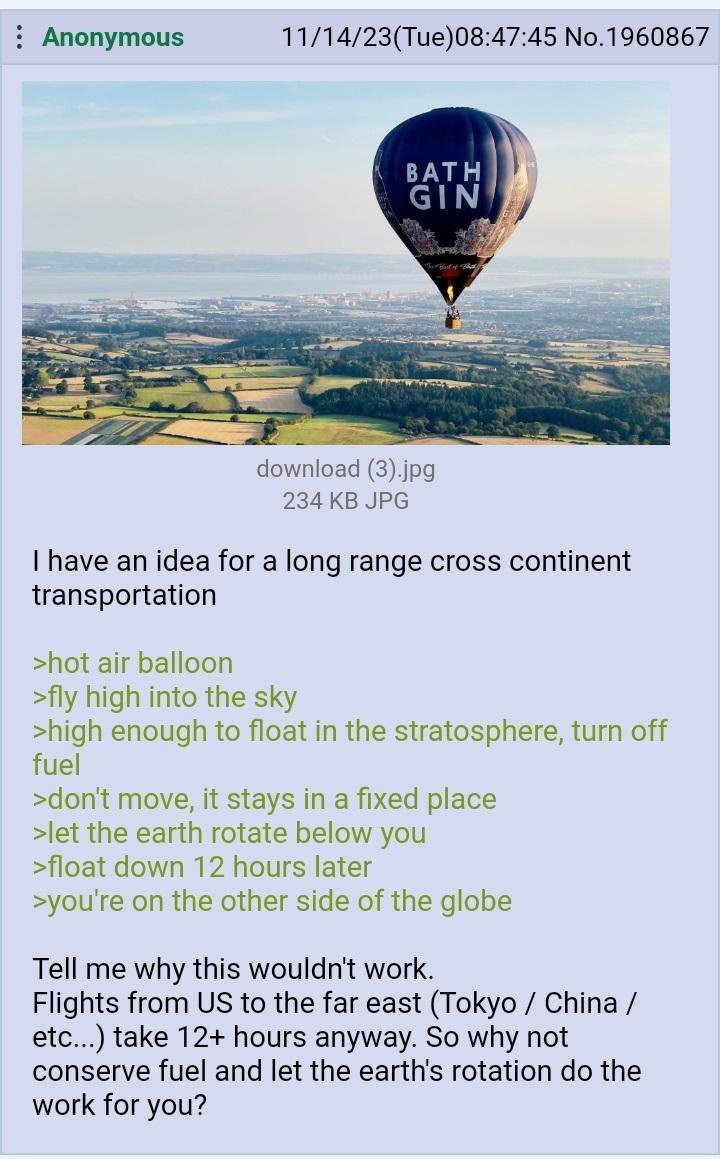this post was submitted on 04 Feb 2024
309 points (95.8% liked)
Greentext
6116 readers
1166 users here now
This is a place to share greentexts and witness the confounding life of Anon. If you're new to the Greentext community, think of it as a sort of zoo with Anon as the main attraction.
Be warned:
- Anon is often crazy.
- Anon is often depressed.
- Anon frequently shares thoughts that are immature, offensive, or incomprehensible.
If you find yourself getting angry (or god forbid, agreeing) with something Anon has said, you might be doing it wrong.
founded 2 years ago
MODERATORS
you are viewing a single comment's thread
view the rest of the comments
view the rest of the comments

The problem is the atmosphere more or less spins with the planet.
Ignore winds for a second, and just imagine the hot air balloon going up. The balloon goes up because the density of the balloon is lower than the air it's displacing. At some height that will no longer be true, and the density of the balloon will be the same as the atmosphere, at that point the balloon can't go any higher. Because of that, the balloon will always be in a fairly dense part of the atmosphere.
So, if it weren't for the winds, the balloon would just rotate with the planet. But, the balloon will be caught in the wind. If it takes off from North America or Western Europe, it's most likely going to end up in a westerly trade wind. If it's going up from South America or Africa the main trade winds would be headed east. Some of these would be hurricane force winds at the surface, but they're still much slower than a jet. So, a balloon could go around the globe, but it would take 3-4x as long as a jet to go the same distance.
These trade winds are how the Chinese spy balloon was launched from China but was able to float over the USA. If a balloon can go up and down in the atmosphere, it can often be directed pretty well towards some specific spot because there's often a wind at some height going the direction needed.
Also, to address the "inventor's" idea that a balloon in the stratosphere would "stay in one place", even if you could completely leave the atmosphere you wouldn't stay in one place. Anything going up from the surface would have a certain amount of angular momentum due to the rotation of the earth. At the surface this is 460 meters per second at the equator, or approx 1000 miles per hour. So, if you wanted to not rotate with the earth, you'd have to accelerate to 1000 miles per hour relative to the surface just to be stationary with respect to something outside the planet, like say the sun. You can do this in a jet. In fact, if you take a jet going west, sometimes you end up going more or less the same rotational speed of the planet, just the opposite direction. This can be fun when you take off at 9am, fly for hours, then land at 9am. It gives you pretty brutal jet lag though.
Orbit doesn't really come into it. They're talking about a balloon in the stratosphere. But, if you wanted to go into orbit, to be in orbit you have to accelerate sideways. Whether you're going east to west, west to east or north to south orbit has nothing to do with the rotation of the earth, only its mass. To reach low earth orbit you'd have to get to about 8 km / second, or about 20x as fast as the rotation of the earth. This is what most of the rocket fuel is used for when a rocket puts something into orbit.
In fact, the scenario describes is one where you could never be in orbit. If you're in a fixed place with the earth rotating under you, your orbital velocity is zero, and there's no orbit where that's possible.